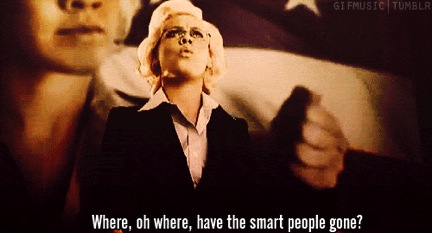From "Stupid Girls" to "Slacktivists:" the Difference 10 Years Makes Among College Women
 The year is 2006. Paris Hilton reigns as the ultimate reality show icon. News channels cover the pursuit of Lindsay Lohan. College women don Abercrombie t-shirts, short ruffled skirts, and oversized white glasses. “Girls Gone Wild” is not only an acceptable archetype; the series based solely around the objectification of women is celebrated. “Video Girls” are scantily clad as they gyrate next to rappers on Total Request Live. Hurricane Katrina hits in December, and the coverage cuts between Britney Spears’ photograph getting out of a car without underwear on and the devastation in New Orleans. Notorious female-power artist Pink is incensed enough to write a song about the state of pop culture.
The year is 2006. Paris Hilton reigns as the ultimate reality show icon. News channels cover the pursuit of Lindsay Lohan. College women don Abercrombie t-shirts, short ruffled skirts, and oversized white glasses. “Girls Gone Wild” is not only an acceptable archetype; the series based solely around the objectification of women is celebrated. “Video Girls” are scantily clad as they gyrate next to rappers on Total Request Live. Hurricane Katrina hits in December, and the coverage cuts between Britney Spears’ photograph getting out of a car without underwear on and the devastation in New Orleans. Notorious female-power artist Pink is incensed enough to write a song about the state of pop culture.
“Disasters all around, World despaired, Your only concern, Will it fuck up my hair?”
The year is 2016. Kim Kardashian reigns. News channels cover a new crop of wild Hollywood girls. College women wear equally scandalous clothing, albeit less pastels. “Girls Gone Wild” has been eradicated, only to have others (potentially Virtual Reality) arise in its place. “Video Girls” have moved to 10-second clips.
But, there’s something different in 2016. College women are seen everywhere consistently standing up for what they believe is right. 2016 has ushered in an entirely new era of women who, despite the pop culture surrounding them, turn to the Internet and other platforms in outrage to force society to correct itself. Robin Thicke never stood a chance.
So what’s with the new attitude? Does 10 years automatically make such a difference? What moved college girls from idolizing Paris Hilton in 2006, to Lena Dunham in 2016?
Here are three factors that heavily influenced modern day college women.
- The War
Remember the war? Iraq? Afghanistan? Not even sure where the war is anymore. The everything’s-not-coming-up-roses mindset historically causes individuals to rise to higher conscientiousness. Think: 1960s rebellious, alternative America. Plus, the mistrust in government garnered in this particular wartime could have contributed in a big way to the push-back against societal norms.
- The Economy
When the economy goes to shit, it forces people to take a good, long look at their life choices. In turn, it changes some things. The juxtaposition between 2009 fashion and 2006 fashion tell the tale of an economy tanked, and young women turned “emo.” People pulled back on the ultra-glamorous, and began to find the superfluous attitudes of yesteryear to be intolerable. In 2006, the housing bubble had not yet popped and mindsets of 20-somethings reflected it. In 2016, we’re all just praying to get a job.
- The Actual Issues
2006 was a time of utter chaos in foreign policy. 5 years post 9/11, news stations echoed “Jhihadist” and “Terrorist” sentiment. Now, our issues are much more domestic. Despite the looming threat of ISIS, climate change, unrest in Eastern Europe… OK. We have some big problems on our hands, and we always have. But it seems as though growing up entirely in a time of terror, today’s 20-somethings (born in the mid-90s) are more receptive and understanding of world’s events, as compared to those born in the mid-80s who grew up in a much more carefree climate.
Regardless of why, there's a noticeable change in young women today. From how they dress to what media they consume to what they believe in, one thing is certain: Paris Hilton has been left behind. While Kim K. isn't necessarily anyone to be proud of, it's still refreshing to see Lena Dunham's name next to her's in the headlines.

